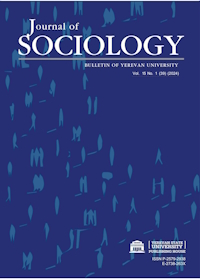CONCEPTUALIZING AND MEASURING ECONOMIC AND SOCIAL ASPECTS OF YOUTH INDEPENDENCE IN ARMENIA
DOI:
https://doi.org/10.46991/BYSU:F/2024.15.1.028Keywords:
Independence index, methodology,, Youth studies, youth independence, youth in ArmeniaAbstract
As youth transition from childhood dependence to adult independence, various dimensions such as financial, economic, mental, daily life independence, and civic participation come into play. The methodology involves quantitative interviews, focus group discussions, in-depth interviews, expert interviews, document analysis, and an academic literature review. The youth independence index encompasses financial independence, economic independence, mental independence, daily life independence, providing a comprehensive approach to understanding and measuring youth independence. Each sub-index is meticulously justified and evaluated using a variety of indicators. Analyzing data from 625 young people aged 18-35 in Armenia, the study reveals insights into the landscape of youth independence. Civic participation stands out as a key area for improvement, while mental and daily life independence demonstrate the highest levels. The analysis considers factors such as age, gender, education, and location, highlighting significant disparities and correlations. The article concludes with considerations for policy interventions and discussions on the representativeness of the chosen sub-indices. The comprehensive framework proposed in this research contributes valuable insights to the field of youth studies, offering a nuanced understanding of the dynamics of youth independence in Armenia.
References
Alwin, D. F. (1988). From Obedience to Autonomy: Changes in Traits Desired in Children, 1924-1978. Public Opinion Quarterly, 52(1), 33. doi:10.1086/269081
Arnett, J.J. (1997). Young people's conceptions of the transition to adulthood. URL: http://jeffreyarnett.com/articles/arnett1997youngpeoplescon ceptionsofthetransitiontoadulthood.pdf
Chisholm, L., Kovacheva, S., Merico M. (2011). European Youth Studies Integrating research, policy and practice. Deliverable 7.1 – M.A. EYS Reader, Innsbruck
Cieslik, M., Simpson, D. (2013). Key concepts in youth studies. Los-Angeles: Sage.
Catani C., (2018), “Mental Health of Children Living in War Zones: A Risk and Protection Perspective”, World Psychiatry, Vol. 17, No. 1․
Escamilla A., Lonean I., Brazienė R., Petkovic S., (2021), Meta-analysis of research on the impact of Covid-19 on the youth sector․ https://pjp-eu.coe.int/documents/42128013/72351197/Meta-analysis-of-research-on-the-Impact-of-Covid-19-on-the-youth-sector.pdf/b174580e-4efb-8d02-5be2-c793d7f40b56
Furlong, A. (2009). Handbook of youth and young adulthood. Roultledge, London-New York.
Furlong, A. (2013). Youth Studies: An Introduction. USA: Routledge.
Galstyan, M. (2022). Re-Conceptualising Youth: Theoretical Overview. Journal of Sociology: Bulletin of Yerevan University, 13(2 (36), 22–27. https://doi.org/10.46991/BYSU:F/2022.13.2.022
Goodwin, J. and O'Conner, H. (2016). Norbert Elias's lost Research: Revisiting the young worker project. Routledge, Taylor and Frances Group, London and New York.
Hromadžić, A․, (2015). Citizens of an empty nation: youth and state-making in postwar Bosnia-Herzegovina. Philadelphia, PA: University of Pennsylvania Press.
Johnson MK, Berg JA and Sirotzki T (2007) Differentiation in self-perceived adulthood: Extending the confluence model of subjective age identity. Social Psychology Quarterly 70(3): 243–261.
Jones, G. (2010). Key concepts: youth. Retrieved April 3, 2019 from: https://www. ukessays.com/essays/sociology/the-concept-of-youth-so-difficult-to-define-sociology-essay.php
Kehily M.J. (2007). Understanding Youth: Perspectives, Identities and Practices. Milton Keynes: Open University Press
Lee J and Mortimer JT (2009) Family socialization, economic self-efficacy, and the attainment of financial independence in early adulthood. Longitudinal and Life Course Studies 1(1): 45–62.
Manzoni, A. (2016). Conceptualizing and measuring youth independence multidimensionally in the United States. Acta Sociologica, 59(4), 362–377. doi:10.1177/0001699316653797
Petkovic S., Ignatovich A., Galstyan M., (2019), YOUTH RESEARCH: THE ESSENTIALS, Council of Europe and European Commission․
Silva JM (2012) Constructing adulthood in an age of uncertainty. American Sociological Review 77(4): 505–522.
White NR (2002) ‘‘Not under my roof!’’: Young people’s experience of home. Youth & Society 34(2): 214–231.
White NR (2002) ‘‘Not under my roof!’’: Young people’s experience of home. Youth & Society 34(2): 214–231.
Корел Л. В. Социология адаптации: вопросы теории, методологии и методики, Новосибирск, 2005. - 424 с
Downloads
Published
How to Cite
Issue
Section
License
Copyright (c) 2024 Marina Galstyan

This work is licensed under a Creative Commons Attribution-NonCommercial 4.0 International License.








